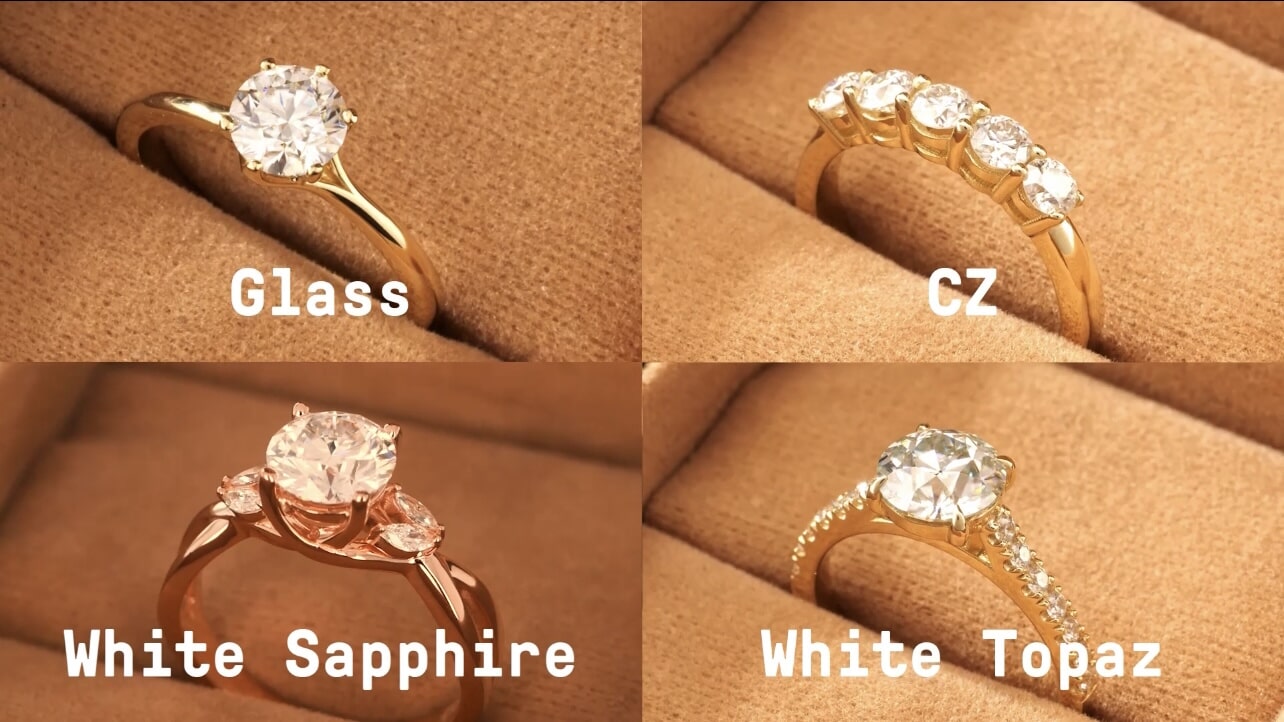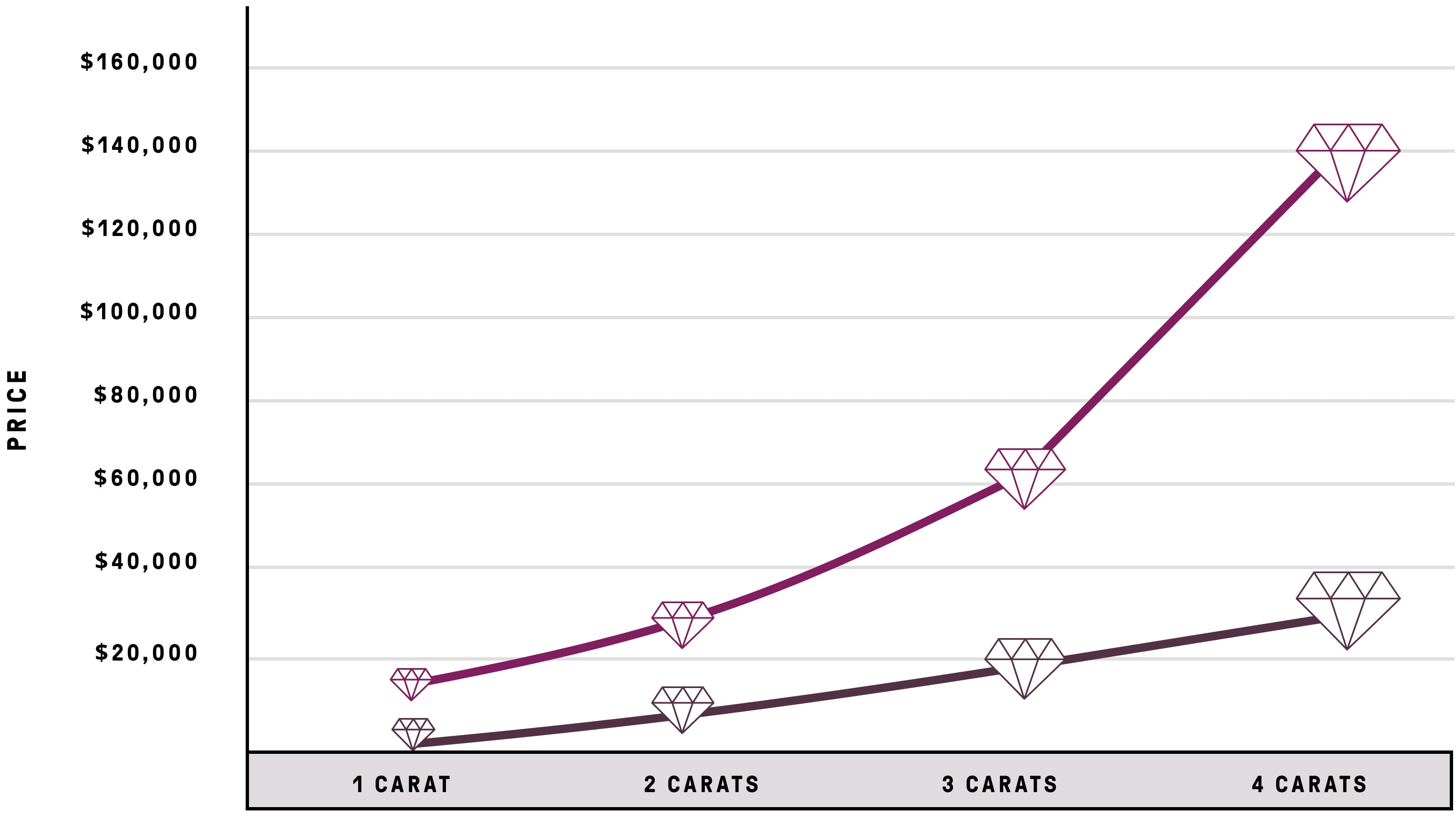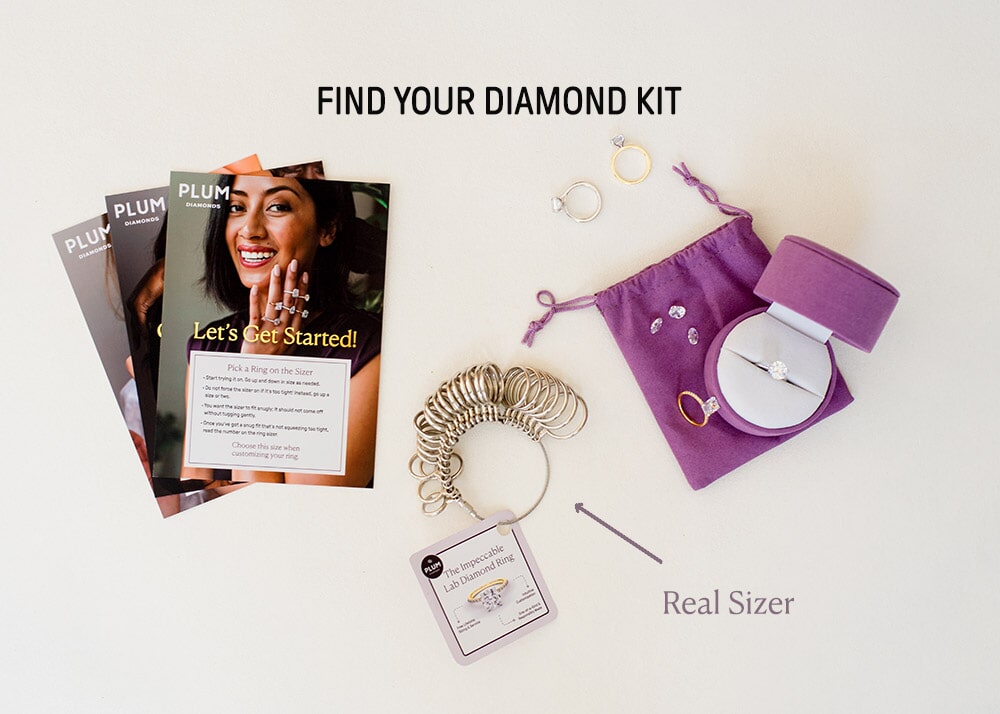How Much Should An Engagement Ring Cost?

MONEY CAN’T BUY LOVE, BUT…
When you hear the words diamond engagement ring, you may immediately think: how much do engagement rings cost? It’s no wonder, because prices for everything seem to be rising, especially in the current economic climate. The price of a quality 2ct diamond can be $30k—if it’s a mined diamond. A similarly-graded lab diamond will be about a quarter of that price—or less.
So, how much do engagement rings cost? The answer depends on a variety of factors, including the size and quality of the gemstone, the metal used in the ring's construction, the quality and design of the setting, any warranties included, and even where you live.
Let's dive in.
How Much Money Should You Spend On an Engagement Ring? Top 5 Factors
FACTOR #1: DIAMOND SIZE AND QUALITY
There are over a dozen “data points” on a diamond certificate that contribute to the price, and it’s true that carat weight is a major factor in the price of lab and mined diamonds. This is because it’s more of a challenge to create larger diamonds, whether in the lab or in the earth. The higher priced the diamond engagement ring, often the higher the diamond carat weight. But not always.
By now you’re probably familiar with other quality factors that go into diamond pricing. Cut grade, color, and clarity round out the 4Cs. If you need a refresher, here’s a summary of the 4Cs and how to choose the perfect diamond.
The higher the diamond is graded on any of these 4C scales, the higher the price. Just remember that you don’t need to be at the top of the scale to get a stunning, high quality diamond. For example, you may not want to shell out for a diamond graded “Flawless” because it’s like paying extra for minuscule clarity improvements that are invisible to the naked eye. Most couples prefer to drop slightly down the clarity scale to get a better value. Learn more about clarity with our helpful diamond clarity chart.
Did you know that some engagement rings are sold with fake diamonds or gemstones?

They're often called cubic zirconia or diamond simulant engagement rings, but don't be fooled into thinking that they're real diamond engagement rings or anywhere near the quality you’ll want for a lifetime. They cost much less for a reason: cubic zirconia and similar simulants lack sparkle, durability, fire, brilliance, longevity, value... they just don't compare to lab grown diamonds or mined diamonds.
These diamond imposters cost way less than the real deal, but as the old adage goes, you get what you pay for. As jewelers and people who appreciate quality, we don't recommend simulants because they don't wear well and get scratched and cloudy. Forget about passing them down to the next generation.
So what do you do if you want a real diamond, but don't want to pay upwards of $20-30k or more? It's definitely time to consider lab grown diamonds.
Lab created diamonds are real diamonds that have been created in a laboratory. They look, feel, and wear the way mined diamonds do - but are much friendlier to the planet (and your wallet). And the beauty of lab grown diamonds is that you get the same type of unique diamond found in nature, but better - lab pricing is so much more attractive that most couples go for a much higher carat weight, higher quality lab diamond. For a much better price.

FACTOR #2: PRECIOUS METALS USED
Engagement rings can be made from a number of different metals, but if you want lifetime quality, there are two metals to consider: platinum and gold. We don't recommend or offer silver because it's too soft and light for a lifetime of wear. Gold and platinum are valuable precious metals suitable for wedding and engagement jewelry. With regular maintenance, they will last a lifetime and beyond.
Precious metal pricing is determined by global metal markets. Platinum tends to be the most valuable engagement ring metal, in part because it’s so rare. It’s also hypoallergenic and is not mixed with other metals, so this pure metal is safe for wearers with sensitive skin. Platinum engagement rings are extremely durable and won't tarnish over time. The metal is notably dense, which makes platinum engagement rings slightly heavier and more durable than gold engagement rings.
A cool fact: when platinum is polished, metal never wears away, it's only pushed around a bit. So your ring won't lose weight over time with wear or maintenance.
Gold engagement rings, on the other hand, are less dense and slightly lighter than platinum, which also makes them lower priced. This is one of the reasons why gold engagement rings are so popular. Another reason is because gold can be mixed with other metals to make white and rose colored gold.
If you have a gold engagement ring with platinum prongs (a “two-toned engagement ring”), the price could be closer to the cost of a completely platinum ring. Why? Because there are labor and material costs involved in creating two-toned rings, adding to their beauty and value.
Silver engagement rings are less dense than platinum and gold engagement rings. This makes them less expensive but also less durable. Because silver prongs are so soft, diamonds can more easily pop out of silver settings. Stay away from silver if you want something that doesn't tarnish, will last forever, and has higher value.


FACTOR #3: SETTING QUALITY & DESIGN
It’s true that quality is partially determined by metal type. However, there’s more to setting quality than metal selection; a high quality engagement ring will be designed for durability and beauty.
On the durability side, the ring should be crafted to width and weight tolerances to make it strong enough for a lifetime of wear. Featherweight settings may cost less in the short term, but tend to cause trouble down the road when they bend or break.
As far as beauty goes, this is obviously a more subjective question. However, cheaply made engagement rings are usually mass-produced - and they actually look like they’ve been mass-produced. For example, the center diamond might be set in a way where it doesn’t fit properly or looks clunky. Or the ring might have unintended sharp edges or boxy angles.
A high quality ring will hold the center diamond in a setting that looks integrated with the overall ring design and fits properly and safely. Same goes for any accent diamonds: the settings should be attractive and secure, set by an expert jeweler. Inexperienced jewelers might charge less, but you could eventually pay for the cost of loose diamonds and repairs, which brings us to…
FACTOR #4: WARRANTIES & AFTER CARE
This is an important part of ring-buying that many couples forget to consider: “what happens after I buy the engagement ring and need ring maintenance?” Maintenance might involve ring sizing, polishing or cleaning, replating white gold, or checking prongs. Engagement rings and fine jewelry do require care post-purchase that can add up. Depending on where you live, resizing for example can run into the hundreds of dollars.
So when you’re looking at the cost of engagement rings, check to see whether you’ll need to add a warranty package or budget for future maintenance (Plum Diamonds provides free sizing and maintenance for life).
FACTOR #5: WHERE YOU LIVE
It's true that the cost of engagement rings varies depending on where you live, especially if you're shopping in-person.
For example, engagement ring prices in New York City may be much higher than engagement ring prices in other parts of the United States. This is because New York City has a higher cost of living, and therefore jewelers may price their items accordingly.
Too far from a good jeweler? Try our Find Your Diamond Kit from the comfort of home. Order your kit now.
Try our Find Your Diamond Kit from the comfort of home. Order your kit now.
Beware of promises of “wholesale prices,” however, as these merchants may not be trustworthy. We recommend doing your homework, working with a reputable jeweler who plans to be in business for the long haul, and questioning anything that sounds too good to be true. Check out Erika's tips for engagement ring shopping online.
The beauty of shopping online versus in-person means that outside of tax, the cost of goods can be the same regardless of where you live. You can shop engagement rings from anywhere and still receive the same level of engagement ring value.
What is The Average Cost Of an Engagement Ring?
As mentioned before, various factors can determine the cost of an engagement ring, from the diamond size to the metal choice, and even your location. But if you live in the United States, you can narrow this price down even further. The average engagement ring cost in the U.S can range between $5,000 and $7,000. This of course is by no means a required price to spend, factoring in your personal budget and ring preferences.
When comparing mined and lab-grown diamonds, when it comes to the cost of an engagement ring, you’ll find a significant difference. Lab grown diamonds can be 20% to 40% less expensive than mined diamonds, while still giving the same quality level. This difference can make or break what you expect to spend on an engagement ring.
What Is a Realistic Budget for an Engagement Ring?
No matter the average cost of an engagement ring or the many factors that play a role in the final cost, what you decide to spend will heavily rely on your budget. The traditional “two or three months” salary rule is a bit outdated and might not fit your financial situation. Instead, focus on what feels right for you. For many, a budget between $1,000 and $5,000 is common, but the most important thing is to choose a ring that reflects your commitment, regardless of the price you see on the price tag.
Lab grown diamonds can stretch your budget further, allowing you to potentially opt for a larger or higher-quality stone without treading too far from your financial comfort zone.
How to Buy an Engagement Ring?
You’ve done the research on costs, you’ve set the budget, and now it’s time to make the next move - purchasing the ring. This move can bring on a lot of emotions, you want to make sure you get it right. To alleviate some of the pressures of swiping your card, keep these things is mind:
- Set Your Budget: Once you have a budget that gets you halfway through the battle of making a final decision on an engagement ring.
- Consider The 4Cs: Familiarizing yourself with the 4Cs (Cut, Color, Clarity, Carat Weight), helps you get the most value for your money.
- Choose a Style: You can easily narrow down your options and hone in on a price when you know what you’re looking for when it comes to the style of your ring. Are you looking for a cushion cut, platinum metals, or looking to create a ring from scratch? Knowing the answers can get you closer to making a purchase.
- Mined vs. Lab-Grown Diamonds: Considering the two can be the difference between you saving money or stretching your budget to get your hands (or finger) on the ideal engagement ring.
- Buy From a Reputable Jeweler: A jeweler with a solid reputation backed by customer reviews and stamps of quality approval like the top diamond certifications is important to consider when purchasing an engagement ring.
ALL IN ALL...
No matter where you live, engagement rings are a special investment you’re going to treasure for life. Lab created diamonds are now an option that tick all the engagement-ring worthy boxes: real diamonds, last a lifetime, eco-friendly, and priced modestly.
With the right information, you can make sure that you're getting an impeccable diamond engagement ring at the best price possible for your needs. Try browsing Plum’s favorite lab grown diamond engagement rings to get started!
Need help finding your perfectly priced diamond engagement ring? Contact us



 GIFTS
GIFTS





 GIFTS
GIFTS



